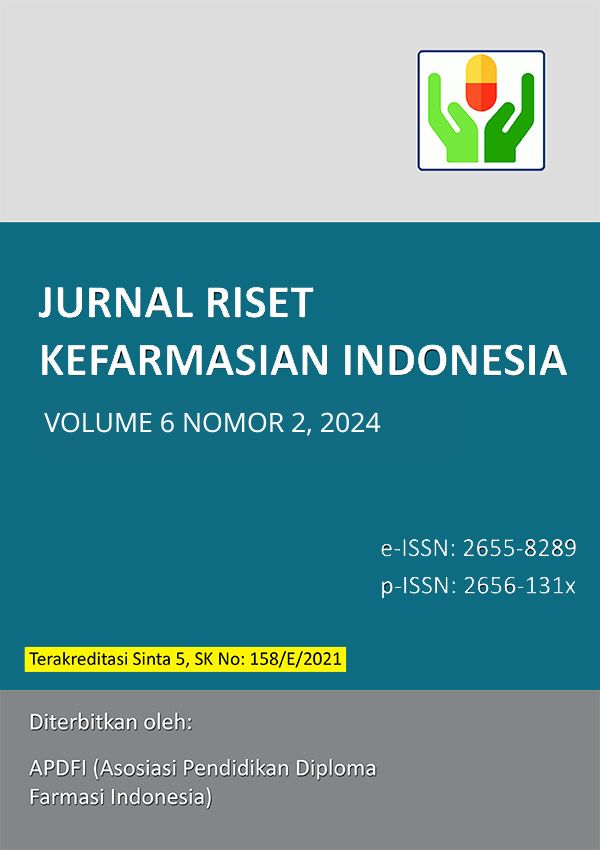FORMULASI SEDIAAN DEODORAN SPRAY EKSTRAKDAUN MANGKOKAN (Polyscias scutellaria (Burm.f.) Fosberg) DAN UJI EFEKTIVITAS ANTIBAKTERI Staphylococcus epidermidis
DOI:
https://doi.org/10.33759/jrki.v6i2.525Keywords:
Tanaman Mangkokan, Deodoran Spray, Staphylococcus epidermidis.Abstract
The mangkokan plant (Polyscias scutellaria (Burm.f.) Fosberg) has properties as a diuretic, anti-inflammatory, breast inflammation, swelling and promotes milk production. Mangkokan leaves have antibacterial activity against bacteria that cause body odor. The purpose of this study was to determine the formulation and effectiveness of the antibacterial deodorant spray of mangkokan leaf extract (Polyscias scutellaria (Burm.f.) Fosberg) against Staphylococcus epidermidis bacteria ATCC 12228. The type of research used is in-vitro experimental. Mangkokan leaf extract is formulated in the form of a deodorant spray with a concentration of 10%, 15% and 20%. Preparation evaluation includes organoleptic, pH and viscosity tests. Antibacterial activity testing was carried out in-vitro using the disc diffusion method against S. epidermidis bacteria ATCC 12228. The results showed that the secondary metabolites contained in mangkokan leaves (Polyscias scutellaria (Burm.f.) Fosberg) were alkaloids, flavonoids, saponins, tannins and terpenoids. Mangkokan leaf extract spray deodorant preparation (Polyscias scutellaria (Burm.f.) Fosberg) can inhibit the growth of Staphylococcus epidermidis bacteria ATCC 12228 shown at a concentration of 20% with an average inhibition zone of 7.06 mm in the medium category. Preparation of deodorant spray for mangkokan leaf extract (Polyscias scutellaria (Burm.f.) Fosberg) with a concentration of 10%, 15% and 20% according to the requirements of SNI 16-4951-1998 namely organoleptic test, pH test, spray pattern, but does not meet the homogeneity requirements because there are extract granules. The results of data analysis using Kruskal Wallis obtained Asymp.Sig 0.015 (Sig. <0.05) which means that they reject H0 and accept H1. There was also a significant difference between F1 and the positive control.
Downloads
References
Ajizah, A. (2004). Sensitivitas Salmonella Typhimurium Terhadap Ekstrak Daun Psidium Guajava L. In BIOSCIENTIAE (Vol. 1, Issue 1).
Cushnie, T. P., & A. J. Lamb. (2005). Antimicrobial Activity of Flavonoids. International Journal of Antimicrobial Agents, 343–356.
Davis, W. W., & Stout, T. R. (1971). Disc Plate Method of Microbiological Antibiotic Assay. MICROBIOLOGY : 33, 659–665.
Faridatussaadah, S. N., Lukmayani, Y., Dasuki, U. A., Farmasi, P., Matematika, F., Ilmu, D., & Alam, P. (2016). Prosiding Farmasi Isolasi dan Identifikasi Senyawa Flavonoid dari Daun Mangkokan (Polyscias scutellarium (Burm.f.) Fosb). Jurnal Farmasi, 2(1), 141–150.
Fissy, Syf. O. N., Sari, R., & Pratiwi, Liza. (2013). Efektivitas Gel Anti Jerawat Ekstrak Etanol Rimpang Jahe Merah (Zingiber officinale Rosc. Var. Rubrum) terhadap Propionibacterium acnes dan Staphylococcus epidermidis. JURNAL ILMU KEFARMASIAN INDONESIA, 12(2), 193–201.
Gunawan, I. W. G., Gede Bawa, G. A., & Sutrisnayanti, N. L. (2008). Isolasi dan Identifikasi Senyawa Terpenoid yang Aktif Antibakteri pada Herba Meniran (Phyllanthus niruri Linn). Jurnal Kimia, 2(1), 31–39.
Jahari, F. (2013). Uji Aktivitas Antibakteri Ekstrak Etanol Daun Mangkokan (Nothopanax scutellarium Merr.) Terhadap Bakteri Penyebab Bau Badan dengan Metode Difusi Agar. Skripsi. UIN Alaudin Makassar.
Khasanah, R. A., Budiyanto, E., & Widiani, N. (2011). Pemanfaatan Ekstrak Sereh (Cymbopogon Nardus L.) Sebagai Alternatif Antibakteri Staph Parfume Spray. 1–9.
Klepak, P. , & Walkey, J. (2000). Antiperspirant and Deodorant. London: Britain Kluwer Academic Publisher.
Marina, R., Endang, D., & Astuti, P. (2012). Potensi Daun Pandan (Pandanus amaryllifolius) dan Mangkokan (Nothopanax scutellarium) Sebagai Repelen Nyamuk Aedes albopictus. Aspirator, 2(4), 85–91.
Nasrul Sani, R., Choirun Nisa, F., Dewi Andriani, R., & Mahar Maligan, J. (2014). Analisis Rendemen dan Skrining Fitokimia Ekstrak Mikroalga. Jurnal Pangan dan Agroindustri, 2(2), 121–126.
Ngajow, M., Abidjulu, J., & Kamu, V. S. (2013). Pengaruh Antibakteri Ekstrak Kulit Batang Matoa (Pometia pinnata) terhadap Bakteri Staphylococcus aureus secara In vitro. Jurnal MIPA UNSTRAT, 2(2), 128–132.
Oktaviana, M. I., Pahalawati, I. N., Kurniasih, N. F., & Genatrika, E. (2019). Formulasi Deodoran Spray dari Minyak Atsiri Daun Kemangi (Ocimum basilicum L.) sebagai Antibakteri Penyebab Bau Badan (Staphylococcus epidermidis). In Pharmaceutical Journal of Indonesia (Vol. 16, Issue 02).
Rahayu, S. , Sherley, & Indrawati, S. (2009). Deodorant-antiperspirant. Jakarta: Naturakos IV BPOM RI.
Susilawati., Y. (2007). Flavonoid Tanin-Polifenol. Universitas Padjadjaran. Jatinagor-Indonesia.
Tranggono, Retno Iswari, & Fatma Latifah. (2007). Buku Pegangan Ilmu Pengetahuan Kosmetik. Gramedia Pustaka Utama.
Downloads
Published
Issue
Section
License
Copyright (c) 2024 Jurnal Riset Kefarmasian Indonesia

This work is licensed under a Creative Commons Attribution-NonCommercial-ShareAlike 4.0 International License.












